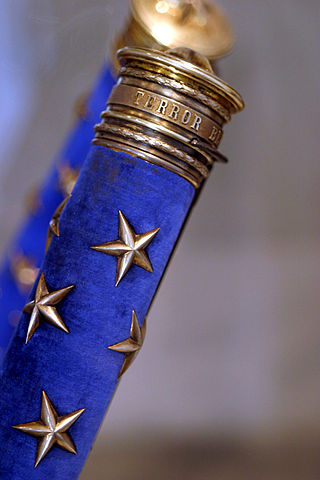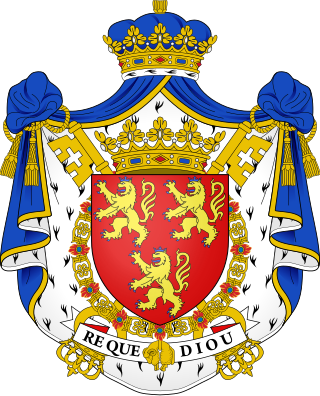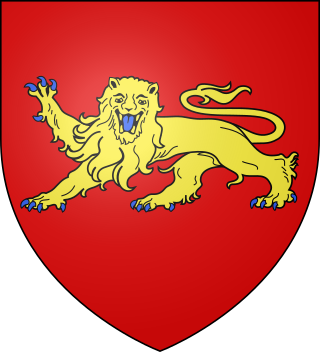Montmorency-Laval is a surname. Notable people with the surname include:

The House of Bourbon is a dynasty that originated in the Kingdom of France as a branch of the Capetian dynasty, the royal House of France. Bourbon kings first ruled France and Navarre in the 16th century. A branch descended from the French Bourbons came to rule Spain in the 18th century and is the current Spanish royal family. Further branches, descended from the Spanish Bourbons, held thrones in Naples, Sicily, and Parma. Today, Spain and Luxembourg have monarchs of the House of Bourbon. The royal Bourbons originated in 1272, when Robert, the youngest son of King Louis IX of France, married the heiress of the lordship of Bourbon. The house continued for three centuries as a cadet branch, serving as nobles under the direct Capetian and Valois kings.

Marshal of France is a French military distinction, rather than a military rank, that is awarded to generals for exceptional achievements. The title has been awarded since 1185, though briefly abolished (1793–1804) and for a period dormant (1870–1916). It was one of the Great Officers of the Crown of France during the Ancien Régime and Bourbon Restoration, and one of the Grand Dignitaries of the Empire during the First French Empire.

Mathieu Jean Felicité de Montmorency, 1st Duke of Montmorency-Laval was a French statesman during the French Revolution and Bourbon Restoration. He was elected as the youngest member of the National Assembly in 1789. He is also known for his military expertise and his relation with Mme de Staël. When France became a republic, Montmorency turned into an ultra-royalist. Napoleon regarded him as a member of the Catholic opposition. During the Restoration, he became Minister of Foreign Affairs.

The House of Montmorency was one of the oldest and most distinguished noble families in France.

The House of Rohan is a Breton family of viscounts, later dukes and princes in the French nobility, coming from the locality of Rohan in Brittany. Their line descends from the viscounts of Porhoët and is said to trace back to the legendary Conan Meriadoc. Through the Porhoët family, the Rohans are related to the Dukes of Brittany, with whom the family intermingled again after its inception. During the Middle Ages, it was one of the most powerful families in the Duchy of Brittany. The Rohans developed ties with the French and English royal houses as well, and they played an important role in French and European history.

The House of La Trémoïlle(Maison de La Trémoille in French) was a French noble family from Poitou whose name comes from the village La Trimouille in the department of Vienne. This family has been known since the middle of the 11th century, and since the 14th century its members have been conspicuous in French history as nobles, military leaders and crusaders, and influential as political leaders, diplomats, Huguenots and courtiers. The male line of the family died out in 1933, while female line heirs of the last duke have kept the La Trémoïlle surname alive in Belgium.

Louis-Joseph de Montmorency-Laval (1724-1808) was a French cardinal of the Catholic Church and Bishop of Metz at the time of the French Revolution.

The House of Talleyrand-Périgord is an ancient French noble house. A well-known member of this family was Charles Maurice de Talleyrand-Périgord (1754–1838), who achieved distinction as a French statesman and diplomat. The family name became extinct in 2003 upon the death of Violette de Talleyrand-Périgord.

Anne de Laval was a French noblewoman. She was the ruling Dame/Seigneur de Laval in 1414–1429.

The title of Duke de La Rochefoucauld is a French peerage, from the great House La Rochefoucauld, cadets of the Lusignan family, whose origins go back to Lord Rochefoucauld in Charente in the 10th century with Foucauld 1st (973–1047), first Lord of La Roche then La Rochefoucauld, possibly son of Adémar, Lord of La Roche (952–1037). They got the title of Baron in the 13th century, then became Count in 1528 with François I de La Rochefoucauld, godfather of King François I and in 1622, François V de La Rochefoucauld, whose son François VI was a leading figure of La Fronde and the author of the Maxims, was made Duke by Louis XIII. They are also, since 16th century, Prince of Marcillac. Then they become during the 18th century: Duke of Liancourt, Duke of Anville and Duke of Estissac. Afterwards : Prince de La Rochefoucauld-Montbel, Duke of Doudeauville, Duke of Estrées and Duke of Bisaccia. They are also: Marquises of Montendre, of Barbezieux, of Surgères and Bayers; also Count de Duretal, Count de La Rochefoucauld-Montbel and Baron de Verteuil. They were : Blessed of the Catholic Church, cardinals, bishops, grand maîtres de la garde robe and Leader of the Kings hunts, chambellans, ministers, lieutenants general of the armies, UK field marshal, Denmark marshal, ambassadors, grand hospitaller of the Order of Malta, presidents and founders of multiple clubs. Many of them were elevated in the Order of the Légion d’Honneur and around 40 of them were/are members of the Sovereign Order of Malta. The castle of La Rochefoucauld is still in the famille since the 10th century. Also to be noted : The La Rochefoucauld-Montbel owned the Lascaux caves at the moment of their discovery and are closely linked to the Pellevoisin sanctuary in France.

Anne-Adrien-Pierre de Montmorency, 1st Duke of San Fernando Luis, 3rd Duke of Laval-Montmorency, GE, was a peer of France and of Spain.

Guy-André-Pierre de Montmorency-Laval, 1st Duke of Laval, 1st Baron of Marche, Marquis of Lezay, was a French general and Marshal of France.

The House of Laval is a family of barons, later counts, coming from the town of Laval, located in Northwestern France, part of the province of Maine before the French Revolution. The Laval were one of the most powerful families of Maine during the Middle Ages and also had a presence in Brittany, where their prestige was similar to the one of the Rohan. The House of Laval played a significant role in Breton history and during the Hundred Years War and the French Wars of Religion. They also favored the French Renaissance in Northwestern France, building several châteaux. The last male heir died during the 17th century, and his possessions went to the House of La Trémoille.
Laval is a French surname and an alternative spelling of "Duval", which literally translates from French to English as "of the valley". It derives from the Norman "Devall", which has both English and French ties. Variant spellings include: Davolls, Deavall, DeVile, Devill, Deville, Divall, Divell and Evill. Its meaning is derived from the French town of Deville, Ardennes. The spelling, "Devall", was first recorded in England in the Domesday Book.
Guy VII of Montmorency-Laval (1219–1267), baron of Vitré, lord of Laval (1264–1267), lord of Acquigny, Aubigné and Olivet. He and his father-in-law, Andrew III, Baron of Vitré, went on crusade and following the death of his father-in-law, he inherited the barony of Vitré, the viscounty of Rennes, and the lands of Marcillé and Aubigné, through his wife Philippa de Vitré. Guy inherited Laval after his mother's death in 1264. He joined the expedition to Italy and died in 1267.

Louis Joseph Charles Amable d'Albert, 6th Duke of Luynes was a French politician, nobleman and member of the House of Albert. He was the sixth Duke of Luynes as well as Duke of Chevreuse.
Anne-Alexandre-Marie-Sulpice-Joseph de Montmorency-Laval, 2nd Duke of Laval was a French politician and soldier.
Eugène-Alexandre de Montmorency-Laval, 4th Duke of Laval, was a 19th-century French soldier.
Guy-André de Montmorency-Laval, Marquis of Lezay and Magnac, Baron of La Marche, was a French aristocrat.